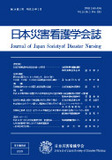Japanese
English
- 有料閲覧
- Abstract 文献概要
- 参考文献 Reference
- サイト内被引用 Cited by
抄録
【目的】平成16年新潟県に設置された応急仮設住宅の室内環境と居住者の生活状況を把握し、高齢者の健康に与える影響を検討する。
【方法】対象は平成16年豪雨水害被災地域4世帯、中越地震被災地域5世帯で、そのうち高齢独居世帯は6世帯であった。調査は梅雨期、残暑期、晩秋期、寒冷期に、各世帯1週間程度の室内温湿度測定と生活状況、健康状態の聞き取りを行った。分析は高齢独居と家族同居の温湿度比較についてノンパラメトリック検定を用いた。
【結果】室内の平均温湿度は、梅雨期と残暑期、晩秋期と寒冷期がほぼ同値で、晩秋期と寒冷期は高齢独居が家族同居より温度が低かった。残暑期の温湿度変動は世帯間で類似したが、寒冷期は大きく異なり暖房器具の使用法が影響した。
【結論】応急仮設住宅の温湿度調整は難しく、高齢者の低体温や熱中症など健康障害の可能性があり、四季を通し生活環境調整の指導や保健福祉サービスの充実が望まれる。
Abstract
Objective:With regard to temporary housing built in Niigata Prefecture in 2004,the aim of this study was to evaluate indoor environments and living conditions in order to examine the influence of living environments on elderly residents’health.
Method:The participants lived in four households in an area affected by heavy rain and flooding in 2004 and five households in an area affected by the Niigata Chuetsu Earthquake of the same year. Elderly residents lived alone in six of the households. The survey was conducted during the rainy season,late summer,late autumn and winter. Each part consisted of around a week of indoor temperature and humidity measurements and interviews regarding the subjects’living conditions and health. Statistical analysis based on nonparametric testing was performed to compare indoor temperatures and humidity in housing for elderly residents living alone with those of elderly residents living with family members.
Results:The average indoor temperature and humidity values were almost the same between early and late summer,as well as between late autumn and winter. During late autumn and winter,indoor temperatures were lower among elderly residents living alone in comparison to the values for those living with family members. Between different households, variations in temperature and humidity were similar in late summer but very different in winter.
Conclusion:The results of the study highlighted the difficulty of maintaining appropriate indoor environments and the risk of related conditions such as hypothermia and heatstroke among elderly residents. There is a need to teach such residents how they can adjust their living environments in response to seasonal changes,and to improve health and welfare services for this demographic.
Copyright © 2013, Japan Society of Disaster Nursing All rights reserved.


